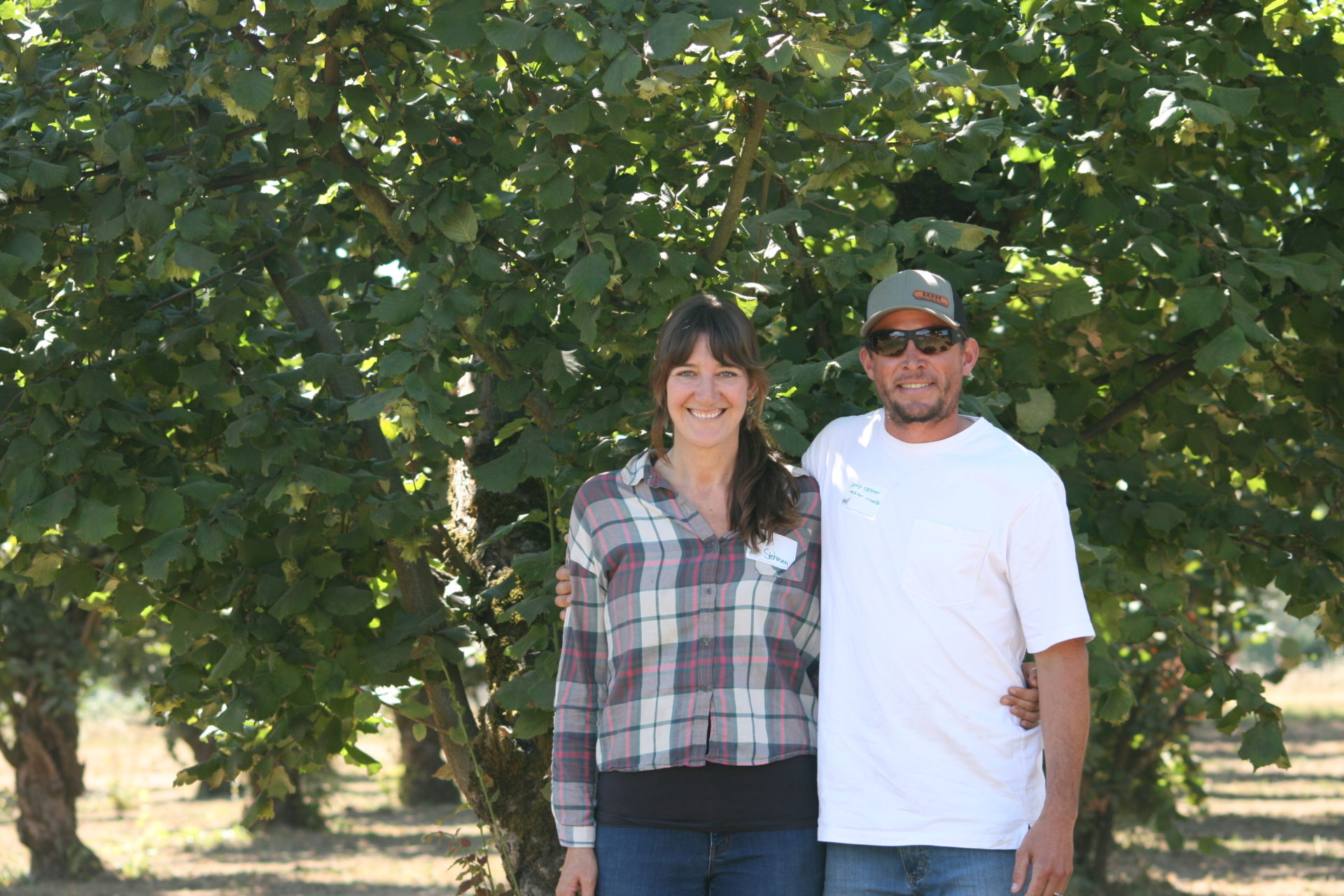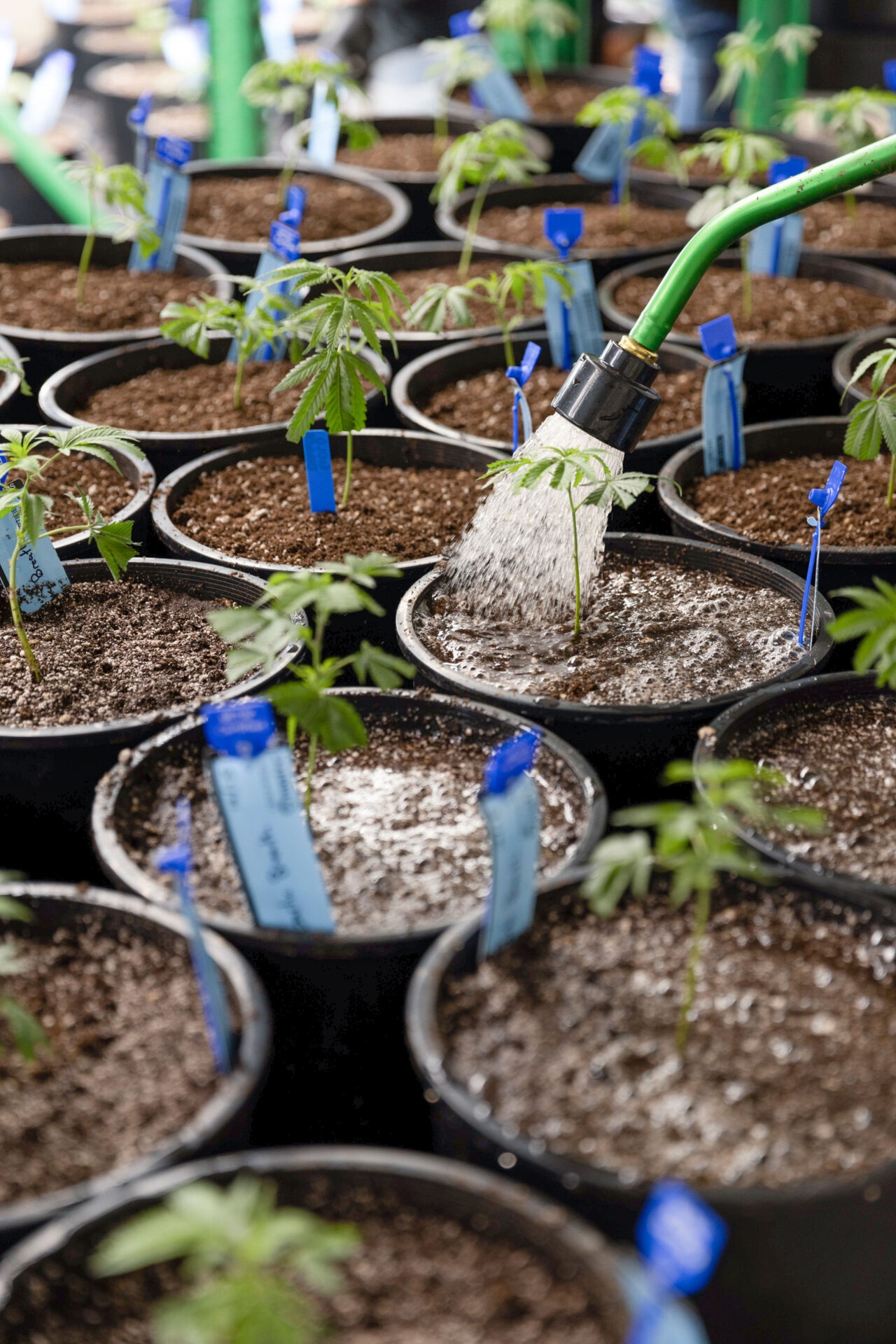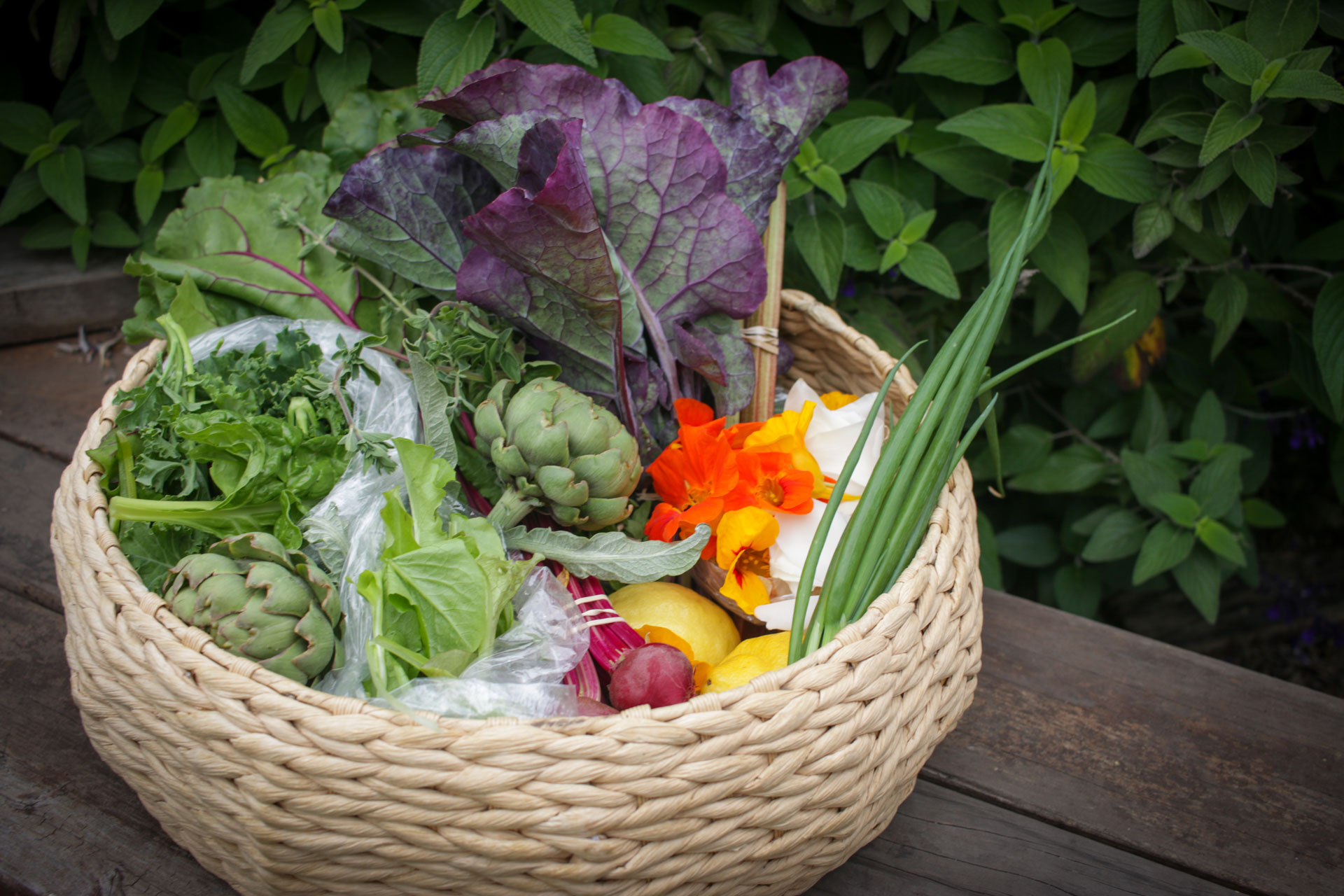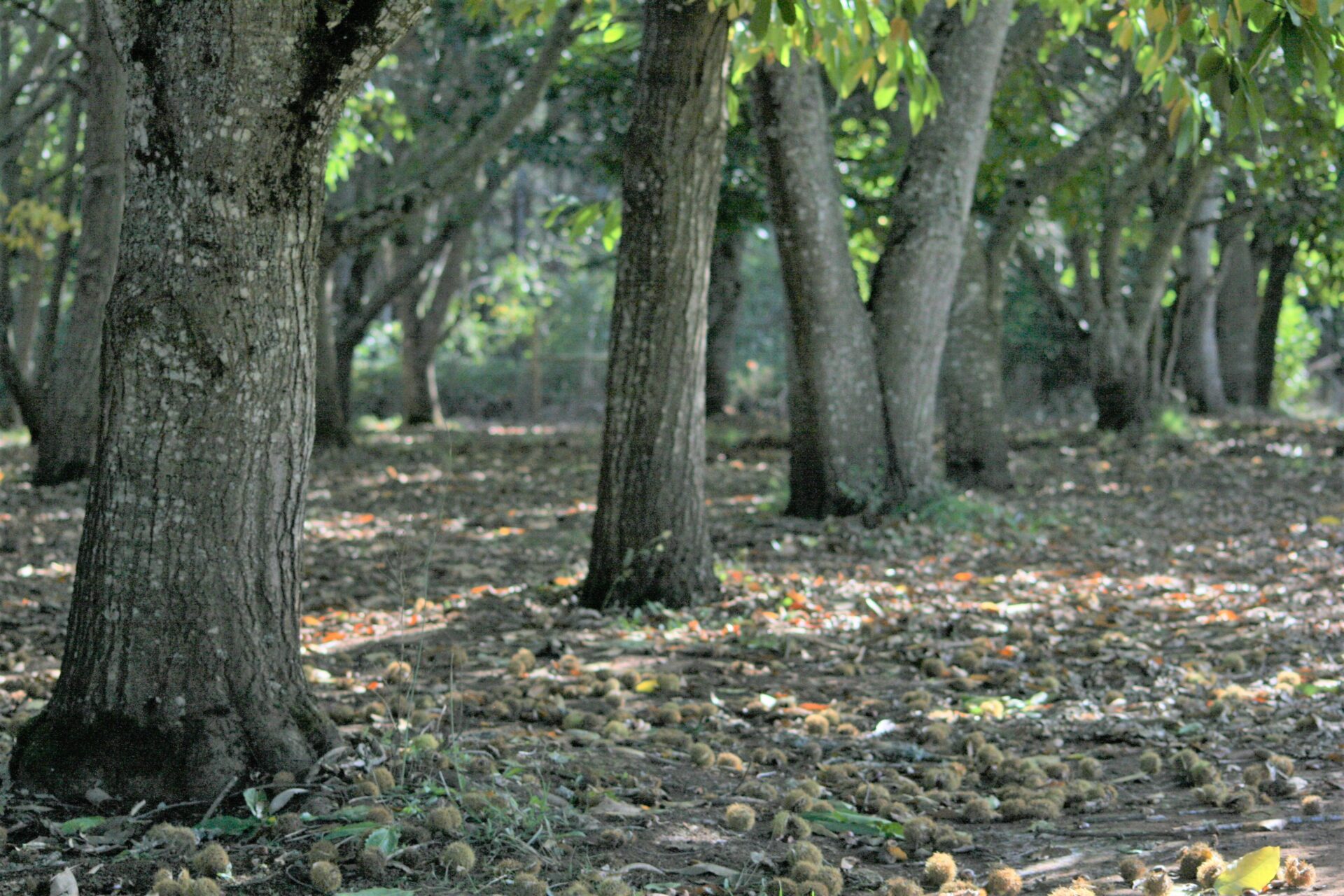
In 1965, Richard Birkemeier and his family planted 40 acres of Barcelona hazelnuts—known then as filberts. In 1966, the Birkemeier family planted another 40 acres, creating Meridian Orchards in Aurora, Oregon. In 1970, the Birkemeiers bought another 40 acres. Richard managed his orchards with conventional farming methods.
Richard’s son, Jim Birkemeier studied biology in college. He found it fascinating. “All the organisms are helping each other. Symbiotic relationship. It’s pretty amazing,” Jim said.
When Jim took over management of the family orchards in 1995, he transitioned the operation to organic growing methods. In the mid-1990s, he went to a sustainability seminar and talked about different things he’d tried: Compost-tea fertilizer; playing high-pitched bird sounds in the orchards to chase away pests; flailing limbs into the soil; grinding down stumps and planting new trees right on top of the stumps. “It was a nightmare,” Jim said. But gradually, he struck a balance with nature. In 1997, Meridian Orchards was certified organic.
Taking the organic leap was difficult, but worth it—not only for Jim’s conscience and the good of the earth, but also monetarily. He was able to mark up his organic nuts about 25 percent over conventional-farmed nuts.
He’s since turned management of the orchards over to his daughter, Mary Birkemeier-Stehman and her husband, David Stehman. “I’m getting older and lazier,” Jim quipped, “so I think it’s a good thing the new generation took over.”
When Mary was a young girl, she thought she’d never leave the family orchards. But as she grew up, she wandered in a different direction. She and David met at Hesston College in Kansas—David is from Kansas. “I came back to it,” Mary said about the orchards. She brought David back with her.
Old Barcelona Orchard
A group of more than 75 people in the hazelnut industry attended the 2019 Summer Farm Tour. The tour was presented by Oregon Organic Hazelnut Cooperative. The group first toured a young organic hazelnut orchard at Skydance Farm in Sherwood. They then traveled to Aurora for a tour of Meridian Orchards—the oldest organic hazelnut orchard in the USA. After hearing a panel of business owners speak during a lunch break, the group followed David and Mary out into the mature orchard.
About the floor in the old Barcelona orchard, David said, “We’ve been scraping and mowing. It’s looking pretty good out here, but we’ll keep working.” This was in mid-August. “We’ve got another month and a half before we’ve got nuts on the ground. So we keep scraping and mowing.” The orchard floor must be as smooth as possible before harvest in order for the sweeper and nut harvester to work properly.
Mary remembers the day when her dad grew cover crops of winter rye and common vetch in the old orchard. “It would get six feet tall,” she said.
David talked about the filbert moth traps that they used in their orchards. He pulled down a trap on a rope-pulley system from the upper third of a tree canopy. Mary peered inside. She tilted the trap this way and that to catch the glimmer of gold scales of the filbert moths’ wings. “There are several little moths in here,” she said, “but I don’t see…wait, there’s one.”
David and Mary have used mating disruption for the past four years to control filbertworm—the nut-eating offspring of filbert moths. They check their pheromone traps regularly. If there are four or five moths in a trap, no problem, David said. “If there are twenty-five to thirty in a trap, we’ll spray with Entrust.” They’ve also been spraying with PyGanic plus Entrust, David said, to “throw the book at the filbert moth.” He’s also tried Grandevo Bioinsecticide. “It smells like chocolate,” he said, “but we didn’t see a good effect with it.”

Replanting
In 1995, the same year that Jim took over orchard management from his dad, Eastern Filbert Blight began working its way down the Willamette Valley. It hit their Barcelona trees. David and Mary are gradually replacing the old blighted Barcelonas with Oregon State University-bred, blight-resistant varieties such as Jefferson and Yamhill. So far, they’ve replanted around 30 acres.
After damage from gophers and borer beetles in some of the young trees, David said they planted more Yamhill and York trees last winter. They planted the new orchards single density, because they like to use equipment, such as flail mowers, in three directions. They also put in irrigation.
For weed control they tried Supress and then Homeplate, “which is easier to work with,” said David about the latter. “We’ve also been around all these trees with a weed eater and hoes.”
Another Young Orchard
The last orchard the group toured was a three-year-old Yamhill, which David said had been sprayed three times, scuffle-hoed twice, and gone over twice with a weed eater.
“We used chicken manure for nitrogen,” he said. Aged chicken manure has been used in the orchards for 50 years. “Phosphorous was through the roof in our soil samples,” David said. “We’ll probably try feather meal.” He said the first couple of years they used compost around the young trees.
David and Mary planted a cover crop of peas, vetch and winter ryegrass down the aisles. “If I can get it tilled again between harvest and weather, we’ll try to plant it again.”
In managing the suckers, David said it’s easiest to hit them with an organic herbicide when they’re less than eight inches tall. Another grower in the crowd said he uses a side cutter on his mower. A side cutter doesn’t get every single sucker, so some hand cutting is still required, but it helps alleviate some of the hand labor.
For irrigation, David uses a water gun on a reel. It stretches and retracts back, he said. It’s not a typical irrigation method for hazelnuts, but he plans to continue irrigating with the gun until it starts hitting the trees. “Then we’ll go from there.”

Pests
Three years ago, they had a real gopher problem. “We didn’t stay on top of it,” David said. When they started planting young trees the gophers became a real issue. They paid a guy a ten-dollar bounty for each gopher, mole and squirrel. David estimated they’ve eliminated around two-thousand gophers in the orchards over the past three years.
David made raptor poles and put up owl boxes, to encourage birds of prey to help keep down populations of voles and field mice. He said growers can use an organic rat poison, but Mary is against using the poison in their orchards.
“I won’t let him,” Mary said. “We’ve been organic from the start, versus conventional for the first three years, then get certified after six years.” She sees importance in maintaining air and water quality. “I have young kids. I want to do something I believe in,” she said through tears, and then chided herself for the show of emotion.
Their hazelnuts are certified organic by Oregon Tilth. “It’s so much more than ‘natural,’” Mary said, noting the word “natural” in food production doesn’t really mean anything. She admits that being certified is costly and a lot of work—including a roughly 39-page application and yearly continuation—but she believes it’s worth it.
Her dad agrees. “So much better than fighting nature, because we wind up fighting ourselves if we do that,” Jim said.
“Some growers using conventional farming methods think it’s impossible to grow hazelnuts organically,” Mary said.
Wash and Dry Lines
With their own wash and dry lines, Meridian Orchards is able to grow, harvest, wash, dry and size their nuts all onsite. They took applications this year to process nuts for other growers, too.
The wash and dry line was built in 2011. “It’s pretty standard equipment in the valley for washing and drying nuts,” David said. “We use SaniDate at the end to rid any bacteria.” The nuts are first washed and de-rocked. The sticks and dirt are removed. “We can blow as hard as needed to blow out the lighter, wormy nuts,” David said.
“We lose some good nuts,” Mary said, “but it’s worth it.” Dirt and debris from the washing process is returned to the orchards.
Then into the dryer the nuts go. Different varieties and differing weather affects drying methods and times.
“Yamhill comes out of the field too dry,” David said. “We actually add moisture at processing.” For a dry year, four to six hours is the typical drying time. Big nuts take longer. Rain-soaked nuts from a wet year can take up to 72 hours. The nuts are dried on gas-heated wooden dryers.
Meridian grades nuts to size in the shell. “Most processors will size again,” David said. They get their nuts shelled elsewhere, bring them back to the farm and store them in a cooler. From there they are mostly sold wholesale in lots of 800 pounds or more.





